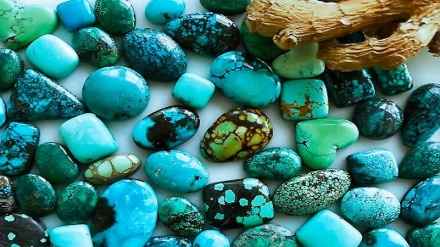Iranian Market (28)
This is another episode of our weekly series, Iranian Market, in which we focus on the goods produced in the Islamic land of Iran. In this edition of the Iranian Market, we’re going to discuss Iranian grapes as a precious agricultural product which has a nutritional value as well as a special status in exportation. Keep us company until the end of the program.
Garden products are one of the subdivisions of agricultural products that have nutritional value, Besides, they have a very important status in export. These products are obtained from growing permanent crops. A permanent crop is one produced from plants which grow for many seasons, rather than being replanted after each harvest. Traditionally, "arable land" included any land suitable for growing of crops even if it were actually used for production of permanent crops such as grapes, peaches, oranges, apples, apricots and pomegranates. Permanent crops are plants that have wooden trunk and after their fruits are picked, a part of or the whole plant remains on the ground and yields fruit in the following years.
Garden products are divided into subdivisions of tropical, subtropical, mild and cold regions. The agricultural products that are produced in tropical and subtropical regions include pistachios, tea, bananas, pomegranates, figs, olives, dates, mangoes, kiwi fruits, and citrus fruits including tangerines, oranges, grapefruits, lemons and limes. In the regions which have cold or mild weather like the mountainous regions of north and west of Iran the fruits like apples, pears, quinces, plums, cherries and black cherries, walnuts, almonds, hazelnuts, and persimmons are cultivated.
The diversity of Iran’s climate has made it possible for farmers to grow different kinds of products. Also, the diversity of Iran’s garden products is unique in the world.
Iran ranks third in the world regarding the diversity of garden products. Out of 25 types of garden products in the world, 15 types are produced in Iran. Iran’s agriculture has a global status and ranks third in the field of growing garden products including pistachios, dates, figs, apples, olives, grapes, pomegranates, and cherries.
In recent decades, with the dramatic increase in the growth of greenhouse products, especially vegetables, cucumbers, tomatoes, eggplants and green peas, these crops have been categorized in the class of exporting goods in Iran.
Among the other characteristic traits of Iran’s garden products is the possibility of producing them in most seasons of the year. Iran with having 37 million hectares of land suitable for farming has the potential for producing different types of garden products. That is why in every province of Iran, gardening is considered as one of the employment fields. More than 50% of Iran’s gardens are located in the provinces of Kerman, Fars, Khorasan Razavi, West Azarbaijan, East Azarbaijan, Mazandaran, and Qazvin.
The favorable climate for producing garden crops as well as the presence of consumption markets around Iran, has attracted foreign traders to invest in the field of garden products in Iran. In this field, mention can be made of the consortium of Iran and several Italian companies.
Among Iranian garden products mention can be made of grapes. Grape is a sweet and delicious fruit with a very high nutritional and economical value. The record history of growing grapes in Iran dates back to over 2 thousand years ago. Therefore, Iranians have been familiarized with the methods of cultivating and producing grapes since old times. Today in most regions of Iran from cold northern regions to the margins of deserts and south different types of grapes are planted and produced.
Furthermore, today more than 300 thousand hectares of Iran’s agricultural lands are under cultivation of different grapes namely, Askari, Shahani, Sahebi, Fakhri, Lal Hosseini, Maraghei, Shaani, Shahroudi, Keshmeshi, Bidaneh, and Yaqouti.
Some of Iran’s provinces including Khorasan Razavi, North Khorasan, Qazvin, West Azarbaijan and East Azarbaijan are the major producers of grapes in the country.
Grape is a fruit with a high nutritional value. Grapes contain vitamins A, B, and C as well as minerals, calcium, iron, magnesium and phosphorous. Grapes also contain a great amount of potassium which is good for treating neural diseases. The nutritional materials in grapes help digest food in the stomach. This fruit is also good for the better functioning of heart, lungs and kidneys.
Raisin is one of the important products of grape. In Iran there are different types of raisins namely, green, yellow, Aftabi, Maviz, and so on.
The Islamic Republic of Iran is the third exporter of different types of raisin in the world. Today, Iran’s raisins are exported to neighboring countries of Iraq, Pakistan, Azerbaijan, Kazakhstan, Turkey and UAE as well as to European countries including Russia, Ukraine, Romania, Hungary, Poland, Spain, Holland, Germany and England and also to African countries of Algeria, Morocco and Egypt.
AE/RM/SS


